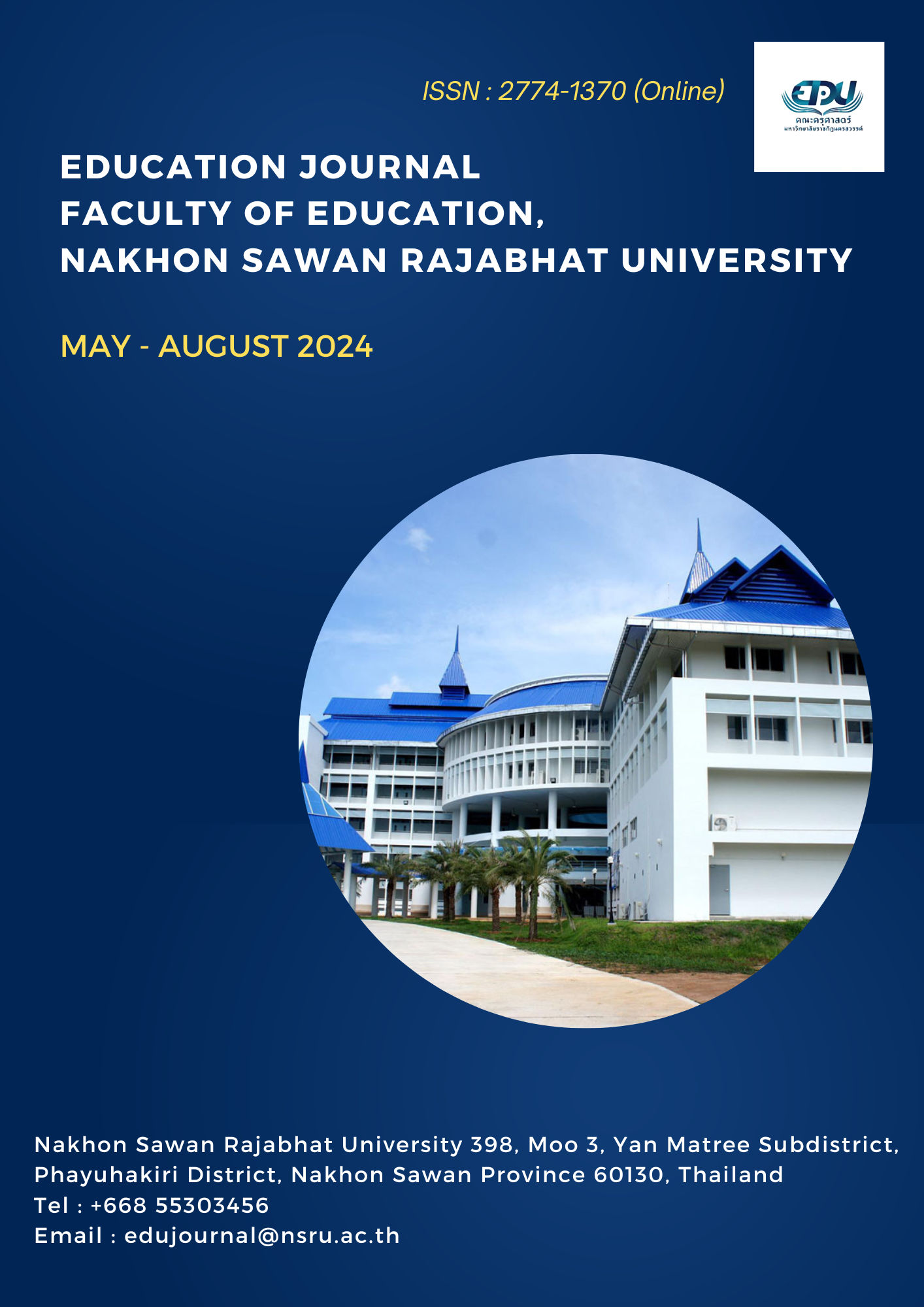ผลการจัดการเรียนรู้แบบร่วมมือด้วยเทคนิคเอสทีเอดีร่วมกับผังกราฟิกที่มีต่อผลสัมฤทธิ์ทางการเรียนและเจตคติต่อการเรียนวิชาคณิตศาสตร์ ของนักเรียนชั้นมัธยมศึกษาปีที่ 1
Main Article Content
บทคัดย่อ
การวิจัยนี้มีวัตถุประสงค์เพื่อ 1) เปรียบเทียบผลสัมฤทธิ์ทางการเรียนของนักเรียนชั้นมัธยมศึกษาปีที่ 1 ก่อนและหลังได้รับการจัดการเรียนรู้แบบร่วมมือด้วยเทคนิคเอสทีเอดีร่วมกับผังกราฟิก 2) เปรียบเทียบผลสัมฤทธิ์ทางการเรียนของนักเรียนชั้นมัธยมศึกษาปีที่ 1 ที่ได้รับการจัดการเรียนรู้แบบร่วมมือด้วยเทคนิคเอสทีเอดีร่วมกับผังกราฟิกกับเกณฑ์ร้อยละ 70 ของคะแนนเต็ม และ 3) ศึกษาเจตคติต่อการเรียนวิชาคณิตศาสตร์ของนักเรียนชั้นมัธยมศึกษาปีที่ 1 ที่มีต่อการเรียนรู้แบบร่วมมือด้วยเทคนิคเอสทีเอดีร่วมกับผังกราฟิก กลุ่มตัวอย่างที่ใช้ในการวิจัยครั้งนี้ได้แก่ นักเรียนชั้นมัธยมศึกษาปีที่ 1 โรงเรียน วัดท่าทอง จำนวน 30 คน ที่ได้มาจากการสุ่มแบบกลุ่ม เครื่องมือที่ใช้ในการวิจัย ได้แก่ 1) แผนการจัดการเรียนรู้แบบร่วมมือด้วยเทคนิคเอสทีเอดีร่วมกับผังกราฟิก เรื่องระบบจำนวนเต็ม จำนวน 6 แผน 2) แบบทดสอบวัดผลสัมฤทธิ์ทางการเรียน เรื่องระบบจำนวนเต็ม มีค่าความเชื่อมั่นเท่ากับ 0.81 3) แบบวัดเจตคติต่อการเรียนวิชาคณิตศาสตร์ มีค่าความเชื่อมั่นเท่ากับ 0.81 สถิติที่ใช้ในการวิเคราะห์ข้อมูล ได้แก่ ร้อยละ ค่าเฉลี่ยส่วนเบี่ยงเบนมาตรฐาน การทดสอบทีแบบกลุ่มไม่เป็นอิสระ และ การทดสอบทีกรณีกลุ่มเดียว ผลการวิจัยพบว่า
1) ผลสัมฤทธิ์ทางการเรียนวิชาคณิตศาสตร์หลังเรียนสูงกว่าก่อนเรียนอย่างมีนัยสำคัญทางสถิติที่ระดับ .05 2) ผลสัมฤทธิ์ทางการเรียนวิชาคณิตศาสตร์สูงกว่าเกณฑ์ร้อยละ 70 ของคะแนนเต็ม อย่างมีนัยสำคัญทางสถิติที่ระดับ .05 3) เจตคติต่อการเรียนวิชาคณิตศาสตร์อยู่ในเกณฑ์ระดับมากที่สุด
Downloads
Article Details

อนุญาตภายใต้เงื่อนไข Creative Commons Attribution-NonCommercial-NoDerivatives 4.0 International License.
เอกสารอ้างอิง
กมลชนก เซ็นแก้ว. (2561). การศึกษาผลสัมฤทธิ์ทางการเรียนวิชาคณิตศาสตร์โดยใช้การจัดการเรียนรู้แบบร่วมมือ เทคนิค STAD ของนักเรียนชั้นมัธยมศึกษาปีที่ 1. วิทยานิพนธ์ครุศาสตรมหาบัณฑิต (คณิตศาสตร์). มหาวิทยาลัยราชภัฏกำแพงเพชร.
กวีชัย จำปา. (2560). การพัฒนาทักษะกระบวนการทางวิทยาศาสตร์ เรื่อง ไฟฟ้ากระแส โดยการจัดการเรียนรู้กลุ่มร่วมมือแบบ STAD ร่วมกับเทคนิคผังกราฟิกของนักเรียนชั้นมัธยมศึกษาปีที่ 5. วิทยานิพนธ์ครุศาสตรมหาบัณฑิต (การสอนวิทยาศาสตร์). มหาวิทยาลัยราชภัฏสกลนคร.
กีรกานต์ คำขาว. (2559). การพัฒนาชุดกิจกรรมการเรียนรู้โดยใช้กระบวนการแก้ปัญหาของโพลยาและผังกราฟิกเพื่อส่งเสริมผลการเรียนรู้ของนักเรียนชั้นมัธยมศึกษาปีที่ 2. วิทยานิพนธ์ครุศาสตรมหาบัณฑิต (หลักสูตรและการสอน). มหาวิทยาลัยราชภัฏเชียงใหม่.
แขไข จันทร์บวร. (2562). การพัฒนาความสามารถในการอ่านคิดวิเคราะห์ภาษาไทยของนักเรียนชั้นประถมศึกษาปีที่ 2 โดยใช้แบบฝึกทักษะการอ่านคิดวิเคราะห์ร่วมกับเทคนิคผังกราฟิก. วารสารวิจัยรำไพพรรณี. 13(1): 179 - 186.
ชัยวัฒน์ สุทธิรัตน์. (2552). 80 นวัตกรรมการจัดการเรียนรู้ที่เน้นผู้เรียนเป็นสำคัญ. กรุงเทพฯ: แดเน็กซ์ อินเตอร์คอร์ปอเรชั่น.
_______. (2555). สอนเด็กให้มีจิตสาธารณะ. (พิมพ์ครั้งที่ 5). กรุงเทพฯ: วีพริ้นท์.
_______. (2558). 80 นวัตกรรมการจัดการเรียนรู้ที่เน้นผู้เรียนเป็นสำคัญ. (พิมพ์ครั้งที่ 6).นนทบุรี: พี บาลานซ์ดีไซด์.
_______. (2559). 80 นวัตกรรมการจัดการเรียนรู้ที่เน้นผู้เรียนเป็นสำคัญ. (พิมพ์ครั้งที่ 7). นนทบุรี: พี บาลานซ์ดีไซด์แอนปริ้นติ้ง.
ณรงค์ กาญจนะ. (2553). เทคนิคและทักษะการสอนเบื้องต้น เล่ม 1. กรุงเทพฯ: จรัลสนิทวงศ์.
เดือนฉาย จงสมชัย. (2554). การพัฒนากิจกรรมการเรียนรู้โดยใช้วิธีการเรียนรู้แบบร่วมมือตามเทคนิค STAD เรื่อง สมการเชิงเส้นตัวแปรเดียว กลุ่มสาระการเรียนรู้คณิตศาสตร์ชั้นมัธยมศึกษาปีที่ 1. วิทยานิพนธ์ครุศาสตรมหาบัณฑิต (หลักสูตรและการสอน). มหาวิทยาลัยราชภัฏมหาสารคาม.
ทิศนา แขมมณี. (2553). ศาสตร์การสอน: องค์ความรู้เพื่อการจัดกระบวนการเรียนรู้ที่มีประสิทธิภาพ. (พิมพ์ครั้งที่ 13). กรุงเทพฯ: สานักพิมพ์แห่งจุฬาลงกรณ์มหาวิทยาลัย.
_______. (2556). ศาสตร์การสอน: องค์ความรู้เพื่อการจัดกระบวนการเรียนรู้ที่มีประสิทธิภาพ. (พิมพ์ครั้งที่ 17). กรุงเทพฯ: สานักพิมพ์แห่งจุฬาลงกรณ์มหาวิทยาลัย.
นันทชัย นวลสอาด. (2554). ชุดกิจกรรมการเรียนการสอน เรื่องอัตราส่วนตรีโกณมิติโดยใช้วิธีการเรียนแบบ ร่วมมือ ด้วยเทคนิค STAD สาหรับนักเรียนชั้นมัธยมศึกษาปีที่ 4. วิทยานิพนธ์การศึกษามหาบัณฑิต (คณิตศาสตร์). มหาวิทยาลัยศรีนครินทรวิโรฒ.
บุญชม ศรีสะอาด. (2553). การวิจัยเบื้องต้น. (พิมพ์ครั้งที่ 8). กรุงเทพฯ: สุวีริยาสาส์น.
พิชิต ฤทธิ์จรูญ. (2559). เทคนิคการวิจัยเพื่อพัฒนาการเรียนรู้. กรุงเทพฯ: สำนักพิมพ์แห่งจุฬาลงกรณ์มหาวิทยาลัย.
สถาบันส่งเสริมการสอนวิทยาศาสตร์และเทคโนโลยี. (2555). คู่มือวัดผลประเมินผลคณิตศาสตร์. กรุงเทพฯ: ผู้แต่ง.
สำนักวิชาการและมาตรฐานการศึกษา, กลุ่มส่งเสริมการเรียนการสอนและประเมินผล. (2548). แผนการจัดการเรียนรู้บูรณาการชั้นประถมศึกษาปีที่ 5 เล่ม 1. กรุงเทพฯ: โรงพิมพ์องค์การรับส่งสินค้าและพัสดุภัณฑ์.
อาภรณ์ ใจเที่ยง. (2553). หลักการสอน. (พิมพ์ครั้งที่ 5). กรุงเทพฯ: โอเดียนสโตร์.
Gardner, H. (1999). Intelligence Reframed: Multiple Intelligences for the 21th Century. New York: Basic Books.
Johnson, D. W., & Johnson, E. P. (1991). Joining Together: Group Theory and Group Skills. Englewood Cliffs, NJ: Prentice-Hall.
Kagan, S., & Kagan, M. (1998). Multiple Intelligences. California: Kagan Cooperative Learning.
Slavin, R. E. (1995). Cooperative Learning: Theory, Research and Practices. (2nd ed.). Boston: Ally and Bacon.


